At Your Boxes:
There are small nestlings in most boxes now, and the adult swallows are kept busy foraging for them, and feeding and brooding them. Believe it or not this is actually a good time to try your hand at sexing and aging Tree Swallows.
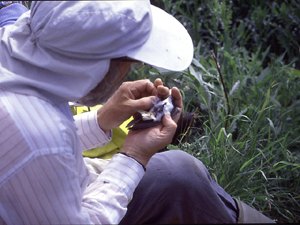
Ever since females started incubating there was a chance that when you checked a box you might find an adult crouched on the nest. You were advised to gently close the door and leave the box alone until the adult left.
However, once hatching has occurred and there are small young in the nests, the parents are much less apt to desert. This presents an opportunity for you to do something different. Now, if you find an adult in a box with small nestlings, grasp it, remove it, and examine it. Note its features close up: its beautiful plumage, its quick dark eyes, its sword-shaped wings, and tiny legs.
Concepts:
How do you safely grasp and remove a swallow from a box?
- Most adults you find in a box will simply crouch down as if trying to hide.
- Open the door just enough to get your hand in and grasp the whole bird from above gently but firmly.
- Never grasp or hold a swallow by the wing, foot or tail. It could flop around and injure itself.
- If the bird eludes your hand and tries to escape through the door, let it go. Don’t try to grab a swallow trying to escape.
- Tree Swallows being removed from a box for sexing and aging often clasp nest material or even nestlings in their feet. Raise each bird gently straight up an inch or two and give it a chance to release whatever it’s clasped. You may need to give it an assist with your other hand.
- Be certain any displaced nestlings are returned gently back directly into the nest cup.
Please note: If you have services of a bird bander you may suggest box-trapping adult Tree Swallows at this stage when they have small young. See how on this page: Banding Adult Tree Swallows.
How do you hold an adult Tree Swallow for examination?
- When sexing and aging Tree Swallows cradle them gently but firmly in your palm (see below).
- Loosely held birds are more apt to try to escape and be injured accidentally.
- Never squeeze a swallow’s body or throat.
- If you notice your bird is gasping for breath, you are holding it to tightly. Release a gasping bird at once.
- Most Tree Swallows won’t struggle much, and they don’t bite.
- They are easy to rotate for viewing top or undersides.
- When you are ready to release a box-trapped swallow, don’t put it back in the box. Simply hold your hand out and open your fingers. It should fly away, but if it doesn’t, raise and then lower your hand slowly until it flies.
- Never toss a swallow into the air to release it.
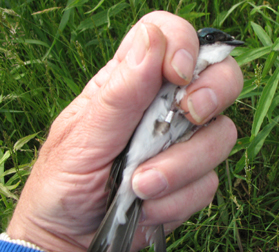
Sexing Tree Swallows:
How can you tell male Tree Swallows from females?
- We can try to use sexual variations in plumage, size or behavior to tell male from female birds in the field, but some species can be hard or impossible to sex this way.
- Tree Swallows are a species that can cause sex identification problems, since males and females sometimes appear exactly the same from a distance.
- But, now that you’re holding a swallow in your hand you’ll be able to tell its sex easily, because during nesting Tree Swallows, like most birds, develop different physical structures related to the sexes’ different roles in breeding.
- Breeding females at this stage have brood patches (BPs).
- Breeding males at this stage have cloacal protuberances (CPs).
To see which structure a swallow has:
- Rotate the bird so its underside faces up.
- Blow gently on its lower belly near its legs.
- This separates its feathers so you can see its BP or CP.
What’s a female’s brood patch?
- In Tree Swallows, as in many songbirds, only females incubate eggs.
- Nesting females shed feathers on a patch of their breast and belly skin. This bare skin swells due to retention of water and expansion of blood vessels and becomes an organ for heat transfer.
- Females press their “BP” against their eggs during incubation and on small young during brooding, transferring their body heat to them.
- A brood patch seen at close range is very obvious. Note the extensive bare BP on this female.
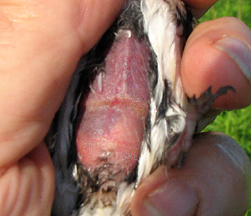
What’s a male’s cloacal protuberance?
- Male songbirds don’t have a penis, but during nesting they develop a swelling of the lower ducts that carry sperm from testes to “cloaca.”
- You’ll remember that the cloaca is the single chamber in birds that receives feces from the intestine, uric acid from the kidneys, and eggs or sperm from the gonads.
- A male’s cloacal protuberance has a storage chamber for sperm. It also helps a male make physical contact with a female’s cloaca so his sperm can be passed to her.
- A cloacal protuberance or “CP” is not as obvious as a female’s brood patch, but is still easy to see in a hand-held male. Note the CP sticking out from the male’s abdomen below. Also note his area of bare skin is much smaller than the female’s BP.
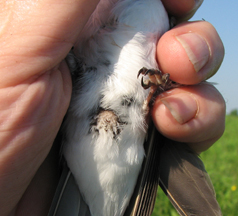
Can you tell male Tree Swallows from females by their plumage?
- Sometimes yes, but mostly no, at least not from a distance.
- All adult males have identical definitive plumage, with iridescent blue upper body and head feathers, dark flight feathers and white underbodies.
- However, only females have delayed plumage maturation. Young females in the spring of their second calendar year of life (their first nesting season) have mostly brown upper surfaces with some blue-green feathers mixed in.
- Luis Villablanca took the photo of the pair below at a California nest box. The male, at left, shows the blue upper body and head of all adult males. The female, at right, illustrates a second-year female’s brown with green highlights.
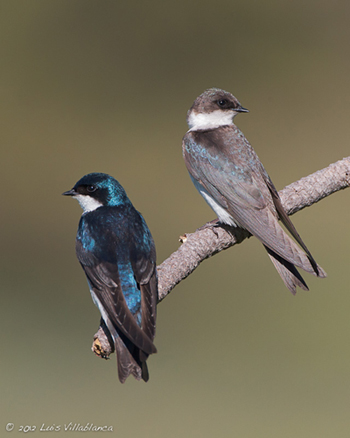
- The amount of blue-green shown by second-year (SY) females varies, as you can see in Ed Craft’s photo near the top of the Tree Swallow Courtship and Pair Formation page.
- However, the following year when they become after-second-year (ASY) birds, females like the one above will almost always acquire a blue plumage similar to the ones males show. From this time on many of these older females cannot be safely told from males by plumage alone.
- But, there is one exception: some after-second-year females show a few brown feathers just above their bills that distinguish them from males.
- Compare the feathers above the bills of the male at left and the after-second-year female at right, in Euan Reid’s photo below.
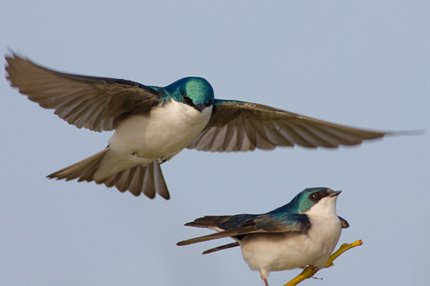
- To summarize, a brownish adult in spring is a female, but most spring females aren’t brownish! The swallows below are both females; SY at left, ASY at right.
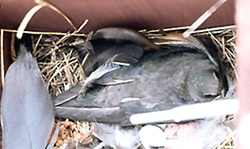
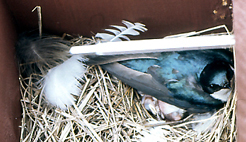
Caution!
- Field guides are often misleading. They will picture a “drab female,” (really a second year female), and state “many are close to males” in color. This is not really accurate.
- Many after-second-year females seem identical to males in outward appearance when viewed from a distance. These birds can’t be told from males, except during the nesting season by BP or CP when held in the hand.
- For example, can you tell the sexes of the pair below?
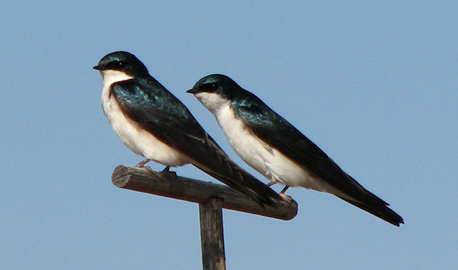
Aging Tree Swallows:
Can you age adult Tree Swallows by plumage?
- In the field adult males all look the same, no matter how old. The most you can do when aging males is say all adult males are “after-hatch-year” (AHY).
- You can age adult females more precisely than males.
- Females that have mostly brownish upper bodies and heads (less than 50% of their upper body and head blue) are in their second calendar year. They are called “second year” (SY) birds, and are in their very first nesting season.
- Females with 90-100% of their upper body and head feathers blue are older, “after-second-year” (ASY) birds, and are in their second or later nesting season.
Let’s check some examples
- Ed Post’s photo below lets us review the three distinguishable adult Tree Swallow age classes.
- The bird on the left is an after-hatch-year (AHY) male, which like all adult males shows a uniform bright blue crown and forehead.
- The brown head with greenish highlights of the bird on the right identify it as a second-year (SY) female, in her very first nesting season.
- And the small brown patch above the bill of the otherwise blue-headed middle bird tell us she is an after-second-year (ASY) female, but remember not all ASY females’ foreheads show this.
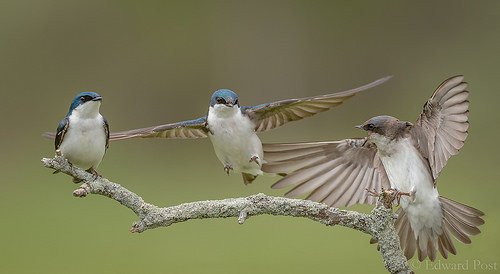
- The birds below are both females.
- The bird at left is an SY, and at right is an ASY.
- Within a few months the SY female will molt, acquiring the blue ASY plumage. From then on she will reacquire blue ASY plumage at every new molt for the rest of her life.
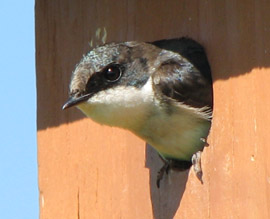

- A very few females are mostly blue (50-90% of their upper body and head feathers blue), with the other 10-50% brown. Recent banding evidence suggests these are almost all SY birds, but we can’t be absolutely certain. In cases like this, when we can’t tell, the most we can say is they are AHY, after-hatch-year birds.
Sexing and aging Tree Swallows by plumage can be tricky, can’t it!
- Researchers determined these sexing and aging guidelines for Tree Swallows we’ve discussed. They banded thousands of Tree Swallow nestlings. Then they examined their plumage as they aged and were recaptured to determine the changes that occurred.
- The diagram below may help you understand the confusing Tree Swallow plumages. The three color possibilities, gray of juveniles, brown and blue of adults, refer to a swallow’s upper body and head, and its wing coverts.
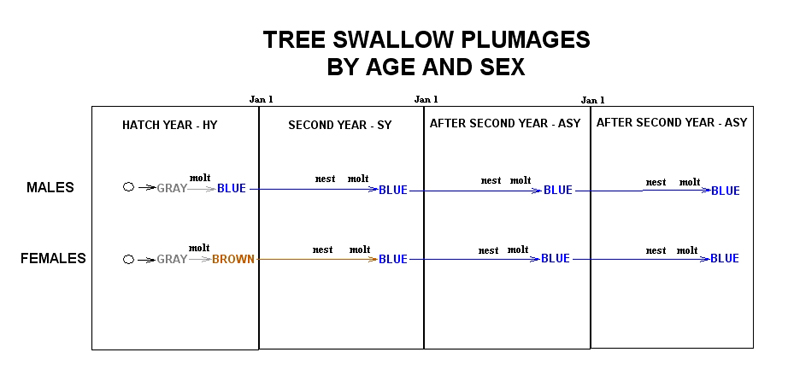
- And here’s a little side note: Using sophisticated instruments researchers have recently found that there are measurable differences in both brightness and hue among male and ASY females, and that older swallows tend to be bluer and brighter.
- In addition, brighter males tend to pair with brighter females, and bluer females have better success raising young.
- It’s probable these subtle (to us) plumage differences function as signals of “quality” that Tree Swallows can use to identify individuals that are older and therefore probably more experienced breeders. These differences could identify birds that have proven they can survive and that could make better potential mates.
- And here’s another little side note: Unlike humans, most songbirds can see far into the ultraviolet portion of the light spectrum, and many have markings visible only in UV that are very important in their identity and behavior. So, in terms of color how a bird looks to another bird may be quite different than it looks to us.
Check for a band.
- One last thing; check each adult you handle for a band. If one is present, note the number and report it online at www.reportband.gov.
Questions for the next topic: Early Nestling Growth and Development
- How are the nestlings changing in appearance and behavior between hatching and when they reach 12 day of age ?
- Is the behavior of the adults changing also?
- Have any nestlings died? If so, any ideas why?
——————————————————————————–
Home: Tree Swallow Nest Box Projects
Creating Tree Swallow Nest Box Projects
Spring Return
Nesting Season Behavior
Song and Calls
Nest Site Claiming
Pair Formation
Nest Building
Bird Flight
Mating and Paternity
Diary of One Season at Salmon Creek
Monitoring Nest Boxes and Keeping Records
Making Box Checks Keeping Box Records Control Sheets Season Summaries Print Sheets
Banding Your Tree Swallows Banding Adults Banding Nestlings
Tree Swallows in Research Research Bibliography Glossary of Terms